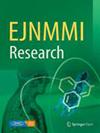Non-invasive quantification of 18F-florbetaben with total-body EXPLORER PET
IF 3.1
3区 医学
Q1 RADIOLOGY, NUCLEAR MEDICINE & MEDICAL IMAGING
引用次数: 0
Abstract
Kinetic modeling of 18F-florbetaben provides important quantification of brain amyloid deposition in research and clinical settings but its use is limited by the requirement of arterial blood data for quantitative PET. The total-body EXPLORER PET scanner supports the dynamic acquisition of a full human body simultaneously and permits noninvasive image-derived input functions (IDIFs) as an alternative to arterial blood sampling. This study quantified brain amyloid burden with kinetic modeling, leveraging dynamic 18F-florbetaben PET in aorta IDIFs and the brain in an elderly cohort. 18F-florbetaben dynamic PET imaging was performed on the EXPLORER system with tracer injection (300 MBq) in 3 individuals with Alzheimer’s disease (AD), 3 with mild cognitive impairment, and 9 healthy controls. Image-derived input functions were extracted from the descending aorta with manual regions of interest based on the first 30 s after injection. Dynamic time-activity curves (TACs) for 110 min were fitted to the two-tissue compartment model (2TCM) using population-based metabolite corrected IDIFs to calculate total and specific distribution volumes (VT, Vs) in key brain regions with early amyloid accumulation. Non-displaceable binding potential ( $$ {BP}_{ND})$$ was also calculated from the multi-reference tissue model (MRTM). Amyloid-positive (AD) patients showed the highest VT and VS in anterior cingulate, posterior cingulate, and precuneus, consistent with $$ {BP}_{ND}$$ analysis. $$ {BP}_{ND} $$ and VT from kinetic models were correlated (r² = 0.46, P < 2 $$ {e}^{-16})$$ with a stronger positive correlation observed in amyloid-positive participants, indicating reliable model fits with the IDIFs. VT from 2TCM was highly correlated ( $$ {r}^{2}$$ = 0.65, P < 2 $$ {e}^{-16}$$ ) with Logan graphical VT estimation. Non-invasive quantification of amyloid binding from total-body 18F-florbetaben PET data is feasible using aorta IDIFs with high agreement between kinetic distribution volume parameters compared to $$ {BP}_{ND} $$ in amyloid-positive and amyloid-negative older individuals.利用全身 EXPLORER PET 无创量化 18F-氟苯并[...
18F-氟贝特宾的动力学模型为研究和临床提供了重要的脑淀粉样沉积量化方法,但其使用受到定量 PET 需要动脉血数据的限制。全身 EXPLORER PET 扫描仪支持同时对整个人体进行动态采集,并允许以非侵入性图像衍生输入函数(IDIF)替代动脉血采样。这项研究利用动态18F-氟贝特宾PET在主动脉IDIF和大脑中对老年人队列进行动态建模,通过动力学建模对大脑淀粉样蛋白负担进行量化。在 EXPLORER 系统上对 3 名阿尔茨海默病(AD)患者、3 名轻度认知障碍患者和 9 名健康对照者注射示踪剂(300 MBq)后进行了 18F-氟贝特宾动态 PET 成像。根据注射后最初 30 秒的手动感兴趣区,从降主动脉提取图像衍生输入函数。利用基于群体的代谢物校正 IDIF,将 110 分钟的动态时间-活动曲线(TAC)拟合到双组织区室模型(2TCM)中,以计算早期淀粉样蛋白聚集的关键脑区的总分布容积和特定分布容积(VT、Vs)。此外,还通过多参考组织模型(MRTM)计算了不可置换结合电位($$ {BP}_{ND})$$。淀粉样蛋白阳性(AD)患者的前扣带回、后扣带回和楔前肌的VT和VS最高,与{BP}_{ND}$$分析结果一致。来自动力学模型的{BP}_{ND}$$和VT具有相关性(r² = 0.46,P < 2 $$ {e}^{-16})$$,在淀粉样蛋白阳性参与者中观察到更强的正相关性,表明与IDIFs的模型拟合可靠。来自 2TCM 的 VT 与 Logan 图形 VT 估算值高度相关($$ {r}^{2}$$ = 0.65,P < 2 $$ {e}^{-16}$$)。在淀粉样蛋白阳性和淀粉样蛋白阴性的老年人中,使用主动脉IDIF与{BP}_{ND}$$相比,动力学分布体积参数之间具有高度的一致性。
本文章由计算机程序翻译,如有差异,请以英文原文为准。
求助全文
约1分钟内获得全文
求助全文
来源期刊

EJNMMI Research
RADIOLOGY, NUCLEAR MEDICINE & MEDICAL IMAGING&nb-
CiteScore
5.90
自引率
3.10%
发文量
72
审稿时长
13 weeks
期刊介绍:
EJNMMI Research publishes new basic, translational and clinical research in the field of nuclear medicine and molecular imaging. Regular features include original research articles, rapid communication of preliminary data on innovative research, interesting case reports, editorials, and letters to the editor. Educational articles on basic sciences, fundamental aspects and controversy related to pre-clinical and clinical research or ethical aspects of research are also welcome. Timely reviews provide updates on current applications, issues in imaging research and translational aspects of nuclear medicine and molecular imaging technologies.
The main emphasis is placed on the development of targeted imaging with radiopharmaceuticals within the broader context of molecular probes to enhance understanding and characterisation of the complex biological processes underlying disease and to develop, test and guide new treatment modalities, including radionuclide therapy.
 求助内容:
求助内容: 应助结果提醒方式:
应助结果提醒方式:


